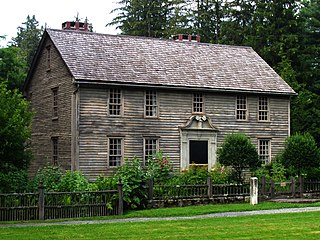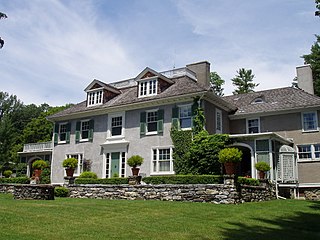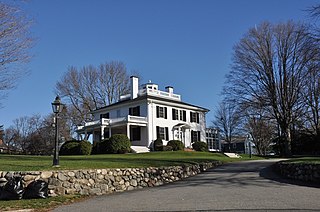
Historic New England, previously known as the Society for the Preservation of New England Antiquities (SPNEA), is a charitable, non-profit, historic preservation organization headquartered in Boston, Massachusetts. It is focused on New England and is the oldest and largest regional preservation organization in the United States. Historic New England owns and operates historic site museums and study properties throughout all of the New England states except Vermont, and serves more than 198,000 visitors and program participants each year. Approximately 48,000 visitors participate in school and youth programs focused on New England heritage.

The Trustees of Reservations is a non-profit land conservation and historic preservation organization dedicated to preserving natural and historical places in the Commonwealth of Massachusetts. It is the oldest land conservation nonprofit organization of its kind in the world and has 100,000 member households as of 2021. In addition to land stewardship, the organization is also active in conservation partnerships, community supported agriculture (CSA), environmental and conservation education, community preservation and development, and green building. The Trustees owns title to 120 properties on 27,000 acres (11,000 ha) in Massachusetts, all of which are open to the public. In addition, it holds 393 conservation restrictions to protect an additional 20,000 acres (8,100 ha). Properties include historic mansions, estates, and gardens; woodland preserves; waterfalls; mountain peaks; wetlands and riverways; coastal bluffs, beaches, and barrier islands; farmland and CSA projects; and archaeological sites.

The Spencer–Peirce–Little Farm is a Colonial American farm located at 5 Little's Lane, Newbury, Massachusetts, United States, in the midst of 231 acres (93 ha) of open land bordering the Merrimack River and Plum Island Sound. The farmhouse, dating to c. 1690, was designated a National Historic Landmark in 1968 as an extremely rare 17th-century stone house in New England. It is now a nonprofit museum owned and operated by Historic New England and open to the public several days a week during the warmer months; an admission fee is charged for non Members.

The General Artemas Ward House is a historic house at 786 Main Street in Shrewsbury, Massachusetts. Commonly known as the "Artemas Ward House", it was the lifelong home of Artemas Ward, American Major General in the American Revolutionary War and a Congressman from Massachusetts. The house is listed on the National Register of Historic Places.

Rippon Lodge is one of the oldest houses remaining in Prince William County, Virginia, and listed on the National Register of Historic Places since 1971. Built around 1747 by Richard Blackburn (1705-1757) as the main residence and headquarters of his plantation, it lies on high ground overlooking Neabsco Creek at the south end of what is now the unincorporated town of Woodbridge at 15520 Blackburn Road. The house takes its name from Richard Blackburn's birthplace, the small city of Ripon in North Yorkshire, England.

The Mission House is an historic house located at 19 Main Street, Stockbridge, Massachusetts. It was built between 1741 and 1742 by a Christian missionary to the local Mahicans. It is a National Historic Landmark, designated in 1968 as a rare surviving example of a colonial mission house. It is now owned and operated as a nonprofit museum by the Trustees of Reservations.

Castle Hill is a 56,881 sq ft (5,284.4 m2) mansion in Ipswich, Massachusetts, which was completed in 1928 as a summer home for Mr. and Mrs. Richard Teller Crane, Jr. It is also the name of the 165-acre (67 ha) drumlin surrounded by sea and salt marsh that the home was built atop. Both are part of the 2,100-acre (850 ha) Crane Estate, located on Argilla Road. The estate includes the historic mansion, 21 outbuildings, and landscapes overlooking Ipswich Bay on the seacoast off Route 1, north of Boston. Its name derives from a promontory in Ipswich, Suffolk, England, from which many early Massachusetts Bay Colony settlers immigrated.

Casey Farm is a historic farm in Saunderstown, Rhode Island, United States. It is now a historic museum property, operated by Historic New England, and is open to the public.

The New Hampshire Farm Museum is a farm museum on White Mountain Highway in Milton, New Hampshire, United States. Three centuries of New Hampshire rural life are presented in the historic farmhouse. The museum includes a 104-foot-long (32 m) three-story great barn with collection of agricultural machinery, farm tools, sleighs and wagons. There are also live farm animals, a nature trail and a museum shop. The museum is located on the former Plumer-Jones Farm, a traditional series of connected buildings with farmhouse dating to the late 18th century and barns dating to the mid 19th century, which was listed on the National Register of Historic Places in 1979.

Greenwood Farm is a historic property and nature reserve located in Ipswich, Massachusetts, and owned by The Trustees of Reservations. The farm is 216 acres of gardens, pastures, meadows, woodlands and salt marsh and it features the PaineHouse, a First Period farmhouse constructed in 1694.

Chesterwood was the summer estate and studio of American sculptor Daniel Chester French (1850–1931) located at 4 Williamsville Road in Stockbridge, Massachusetts. Most of French's originally 150-acre (61 ha) estate is now owned by the National Trust for Historic Preservation, which operates the property as a museum and sculpture garden. The property was designated a National Historic Landmark in 1965 in recognition of French's importance in American sculpture.

Craftsman Farms is a historic house located in Parsippany-Troy Hills, Morris County, New Jersey, United States. It was founded by noted early 20th century designer Gustav Stickley as a farm and school for the Arts and Crafts movement. It remained in use until 1915 when it was sold to a family and became a private house.

Beebe Homestead, also known as the Lucius Beebe House and Beebe Farm, is a historic Federal period home at 142 Main Street in Wakefield, Massachusetts, which was built during the federal era that extended from the late 18th-century into the 1820s. It is suspected to have been remodeled into the federal style from an earlier home built in circa 1727. It overlooks Lake Quannapowitt, and according to a 1989 study of historic sites in Wakefield, the house is "one of Wakefield's most imposing landmarks." The property was added to the National Register of Historic Places in 1989.

The Landmark Inn State Historic Site is a historic inn in Castroville, Texas, United States. It serves the general public as both a state historic site and inn eight overnight rooms.

The Bowman House is a historic house museum on Bowman Lane, off Maine State Route 128, in Dresden, Maine, United States. It was built in 1762, early in the area's colonial settlement history, and later served as the office of an ice harvesting business. The house was listed on the National Register of Historic Places on April 7, 1971, under the name Bowman-Carney House. It is now a museum owned and managed by Historic New England.

Adaland is a historic house located at Berryburg, Barbour County, West Virginia.

The Red Mill is a 4-story grist mill located along the South Branch Raritan River at 56 Main Street in Clinton, New Jersey. It was built c. 1810 as an industrial mill. It has served several roles, including a wool processing plant, a peach basket factory, and a textile mill. Historically known as the David McKinney Mill, it was added to the National Register of Historic Places on January 8, 1974 for its significance in agriculture and commerce. In 1995, it was also listed as a contributing property of the Clinton Historic District. It is now part of the Red Mill Museum Village, an open-air museum previously known as the Clinton Historical Museum.

The Parson Smith House is a historic house on River Road in southern Windham, Maine. Built in 1764 and virtually unaltered since, it is one of the state's finest examples of Colonial Georgian architecture. It was listed on the National Register of Historic Places in 1973. Now a private residence, it was for 40 years a historic house museum owned and operated by the Society for the Preservation of New England Antiquities.





















